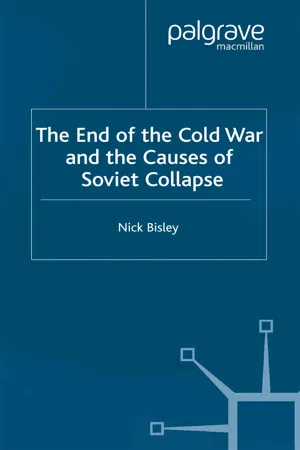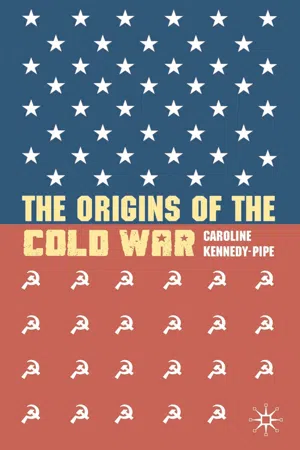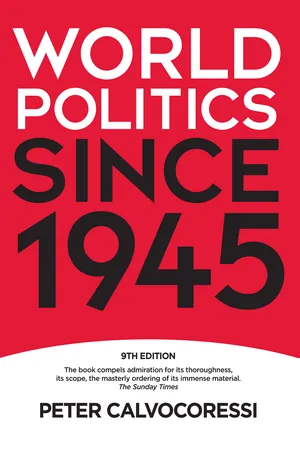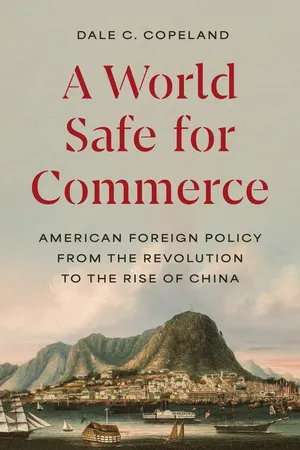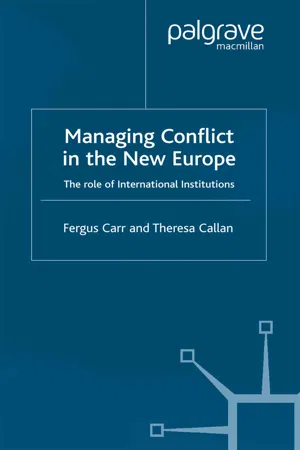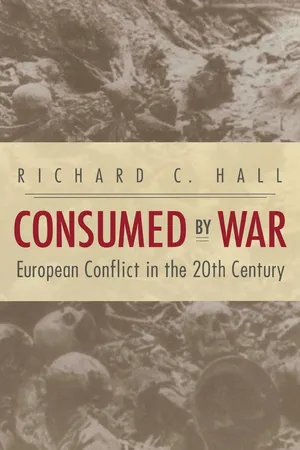History
Second Cold War
The "Second Cold War" refers to a period of renewed geopolitical tension and rivalry between the United States and Russia following the end of the original Cold War. This era is characterized by competition in areas such as military power, influence in global affairs, and technological advancements. While not as intense as the first Cold War, it represents a significant shift in international relations.
Written by Perlego with AI-assistance
Related key terms
1 of 5
10 Key excerpts on "Second Cold War"
- N. Bisley(Author)
- 2004(Publication Date)
- Palgrave Macmillan(Publisher)
Such a challenge unsurprisingly provoked reaction which aimed to remove the threat of Soviet communism – both direct and indirect – to the world at large. The counter-revolutionary impulse of 1918–21, the fascist challenge of the 30s and 40s in Italy, Spain and Germany, as well as the hostility of the Cold War were examples of these counter-revolutionary tendencies. Importantly, the confrontation consisted of a long-term underlying socio- economic, ideological and geopolitical hostility between the leading protagonists, before and after the Second World War. The confrontation can be divided into two clear periods: the first, 1917–1941; and the second, 1945–1988. The period between 1941 and 1945 was marked by a state of warfare between one of the confronting powers, fascist Germany and the Soviet Union, as well as a temporary and uneasy alliance between the USSR and the other capitalist powers. The first period consisted of less overt hostility, but nonetheless involved clear competition between the capitalist powers and the USSR. The second period was the Cold War. This second phase of confronta- tion arose for similar reasons as the first phase – the socio-economic, geopolitical and ideological challenge presented by the Soviet Union and the hostility that this engendered in the West. Importantly, the Cold War phase accentuated the competition due to two important developments: nuclear weapons and the spread of Soviet revolutionary models around the world, particularly in the decolonising states of the former European empires. To summarise, the East–West conflict that shaped the Soviet state pre-dated the Cold War. The Cold War itself was the second phase of the 10 End of the Cold War and Causes of Soviet Collapse longer run international confrontation which derived from the Soviet domestic socio-political order.- eBook - PDF
- John Lukacs(Author)
- 2010(Publication Date)
- Yale University Press(Publisher)
161 S E V E N The Second World War and the Origins of the Cold War Many people, including political ‘‘scientists’’ and historians, have seen and still see the ‘‘cold war’’ as a consequence of World Communism. In the United States leading ‘‘conservatives,’’ James Burnham and William Buckley, wrote that in 1917 ‘‘history changed gears.’’ In Germany, Ernst Nolte, a historian, wrote that beginning in 1917, with the Communist revolution in Russia, the entire history of the twentieth century thereafter was that of a ‘‘European civil war.’’ This is—they are—wrong. The ‘‘cold war’’ was a consequence of the Second World War. Its cause was the nature of the Russian occupation of most of Eastern Europe and of eastern Germany. The words cold war came into existence in the United States in 1948. We may pin down the chronological limits of the ‘‘war’’: 1947 to 1989. In 1947 Russian and Commu-nist rule in the eastern portion of Europe became, by and large, 162 The Origins of the Cold War unconditional; in 1989 the Communist governments in Eastern Europe ceased to exist. True, the first reactions of the American government against further Communist or Russian expansion and against the aggressiveness of the Russian government began to appear a year before 1947, and the ending of hostility between the American and Russian governments about two years before 1989, and the final end of Communism and the dissolution of the Soviet Union in 1991: still, it is proper and reasonable to fix the frame, the duration of the cold war, from 1947 to 1989. - eBook - PDF
America in the World
A History in Documents since 1898, Revised and Updated
- Jeffrey A. Engel, Mark Atwood Lawrence, Andrew Preston, Jeffrey A. Engel, Mark Atwood Lawrence, Andrew Preston, Mark Lawrence, Jeffrey A. Engel, Andrew Preston(Authors)
- 2023(Publication Date)
- Princeton University Press(Publisher)
7 The Beginning of the Cold War The Soviet-American alliance against Nazi Germany fractured within a few months after the end of the Second World War, and the two superpowers settled into a bitter rivalry that American newspaper columnist Walter Lippmann dubbed a “cold war.” This deterioration resulted from numerous sources of disagreement, some of them rooted long before 1945. The two nations had regarded each other warily ever since the Bolshevik Revolution of 1917 had brought communists to power in Russia and established a national ideology opposed to the American creed of free enterprise and democracy. The outbreak of global war in 1941 thrust Washington and Moscow together as partners against fascism, yet old resentments festered. The Cold War resulted not just from past disagreements, however, but also from conflicting visions of the future. U.S. and Soviet leaders advanced contrasting ideas about how to remake the world once the fighting came to an end. For Joseph Sta- lin, ensuring the physical security of the Soviet Union was paramount. He aimed to destroy German power, assert control over eastern Europe, and extend Soviet influence toward the Mediterranean, oil-rich Southwest Asia, and the Far East. This desire for territorial domination, rooted in a profound sense of insecurity honed by repeated invasions of the Soviet Union, contrasted sharply with U.S. plans for the postwar order. Convinced that global catastrophe—first the Great Depres- sion and then the Second World War—had resulted from nations pursuing nar- row economic and territorial advantages, U.S. leaders hoped to establish an open world order based on free trade, self-determination, and international cooperation. Like Woodrow Wilson in an earlier day, U.S. officials believed that the universal application of such principles would serve the interests not only of the United States but also of the whole international community. - eBook - PDF
- Caroline Kennedy-Pipe(Author)
- 2017(Publication Date)
- Bloomsbury Academic(Publisher)
1 Cold Wars: Themes and Trajectories The Cold War seems to have receded from our memories much more quickly than we might have expected. For many, it is now almost impossible to understand how the Cold War framed practic-ally every aspect of life for over four decades from 1945. With scholars and practitioners now concentrating on the threat from Islamic extremism and the apparent multiple threats posed by radical terrorism, the significance and character of globalization, or the multifarious threats posed by global environmental change, the Union of Soviet Socialist Republics (USSR) and its alleged threat to dominate the Western world through the spread of Soviet-style Communism (a threat which never successfully materialized) has a quaint, almost fusty air about it – like meeting a dimly remembered yet once very formidable maiden aunt. There are many reasons for being concerned about this state of affairs. In the first place, the old adage that those who do not remember their history are doomed to repeat it might be cited; and the first step to remembering history lies in studying it. Naturally, over the last half century there has been a vast amount written on the history of the Cold War, but it is astonishing how quickly much of that literature – once considered central for the student of international relations as much as for the diplomatic historian – has vanished from the reading lists and, indeed, from the general set of assumptions that govern our behaviour. A second reason for concern is that the Cold War has not, of course, ‘gone away’. Rather, it has become submerged. But like geological formations, once the surface crust of the contemporary 12 breaks, the layers that underpin it are visible once again, and if we cannot properly recognize them we may misdiagnose the likely effects. - eBook - PDF
A People and a Nation
A History of the United States
- Jane Kamensky, Carol Sheriff, David W. Blight, Howard Chudacoff(Authors)
- 2017(Publication Date)
- Cengage Learning EMEA(Publisher)
New nations emerged in the postwar international system dominated by the Cold War rivalry of the United States and the Soviet Union. Many newly independent states became targets of great-power intrigue but chose nonalignment in the Cold War. Copyright 2019 Cengage Learning. All Rights Reserved. May not be copied, scanned, or duplicated, in whole or in part. Due to electronic rights, some third party content may be suppressed from the eBook and/or eChapter(s). Editorial review has deemed that any suppressed content does not materially affect the overall learning experience. Cengage Learning reserves the right to remove additional content at any time if subsequent rights restrictions require it. CHAPTER 24 The Cold War and American Globalism | 1945–1961 716 nations could buy American goods and technology, supply strategic raw materials, and invite investments (more than one-third of America’s private foreign investments were in Third World countries in 1959). And they could build cul- tural ties with the United States. Both great powers, more- over, looked to these new states for votes in the United Nations and sought sites within their borders for military and intelligence bases. But often poor and unstable—and rife with tribal, ethnic, and class rivalries—many new nations sought to end the economic, military, and cultural hegemony of the West. Many learned to play off the two superpowers against each other to garner more aid and arms. U.S. interventions—military and otherwise—in the Third World, American leaders believed, became neces- sary to impress Moscow with Washington’s might and to resolve and counter the nationalism and radical anticapital- ist social change that threatened American strategic and economic interests. To thwart nationalist, radical, and communist chal- lenges, the United States directed massive resources—foreign aid, propaganda, development projects—toward the Third World. - eBook - PDF
- Peter Calvocoressi(Author)
- 2013(Publication Date)
- Routledge(Publisher)
At no point did the protagonists directly engage each other but both sought to extend their influence and win territorial advantage in adjacent parts of the world, notably the Middle East and – after its decolonization – Africa. None of these excursions was decisive and for nearly half a century the chief outward expression of the Cold War was not advances or retreats but the accumulation and refinement of the means by which the two sides tried to intimidate each other: that is to say, their arms race. The slackening of the Cold War resulted from the combined effect of the huge cost of these armaments and the gradual waning of the myths which underlay it. In the summer of 1945 it was known both in Washington and Moscow that Japan was ready to acknowledge defeat and abandon the war which it had begun by the attack on Pearl Harbor in 1941. In July the Americans experimentally exploded the first nuclear weapon in the history of mankind and in August they dropped two bombs on Hiroshima and Nagasaki. Japan surrendered forthwith and this clinching of the immi- nent American victory deprived the Russians of all but a token share in the postwar settlement in the Far East. In the European theatre conflict remained for a short time veiled. The organs and habits of wartime collaboration were to be adapted to the problems of peace, not dis- carded. The Russian spring offensive of 1944 had set the USSR on the way to military dominance and political authority in Europe unequalled since Alexander I had ridden into Paris in 1814 with plans for a concert of victors which would order the affairs of Europe and keep them ordered. The nature of mid-twentieth-century great power control was a matter for debate – how far the powers were collectively to order the whole world, how far each was to dominate a sector. The Russians and the British, with the reluctant assent of President Franklin D. - eBook - PDF
A World Safe for Commerce
American Foreign Policy from the Revolution to the Rise of China
- Dale C. Copeland(Author)
- 2024(Publication Date)
- Princeton University Press(Publisher)
By securing a strong economic and political Second World War and Cold War 243 position on the periphery, the United States would be able to direct the post- war recovery of most of the globe and keep the Soviets from drawing large parts of it to its side. If the Soviets decided to work with Washington and keep order within their own smaller sphere, great. But if not, then the United States would have the power base needed to deal with anything that arose in the future, and with the problems on the ground in the present. I will be talking about the causes of the Cold War and the way it played out over forty-five years for the next three chapters. Before I proceed, therefore, I need to briefly address what might seem to be a self-evident truth: that eco- nomic interdependence could have had little to do with either the Cold War’s origins or with the crises and tensions that pockmarked its history until the late 1980s. After all, U.S.-Soviet trade from late 1945 onward remained at very low levels given what seemed to be strong geopolitical reasons for not trading, particularly American fears that trade would promote Soviet relative economic growth within the new more zero-sum, bipolar world Washington now faced. It would thus seem that economic interdependence drops out as a causal vari- able that might explain both the start of the Cold War and its dynamics over some four decades. Indeed, both realists and liberals usually completely ignore the economic aspects of the U.S.-Soviet relationship from 1945 to the 1980s, presuming that low or almost nonexistent trade could not possibly have had much of a role in the Cold War struggle. - eBook - PDF
Managing Conflict in the New Europe
The Role of International Institutions
- F. Carr, Theresa Callan(Authors)
- 2015(Publication Date)
- Palgrave Macmillan(Publisher)
19 2 Conflict in the Cold War and Post-Cold War Worlds Introduction The end of the Cold War heralded a revolution in European security. A Europe divided into rival alliances, separated by an ‘Iron Curtain’ and overshadowed by nuclear confrontation, gave way to a new order. The transition was remarkably swift and far reaching in its consequences. Security understandings were transformed from the notion of ‘threats’ to ‘risks’. The conceptualization of security moved from a military focus to include societal, economic and institutional perspectives. The concern of this book is to examine the challenge faced by security providers in this new, yet transitional, environment. It seeks to analyse the degree to which the European institutional architecture can respond to contemporary challenges of political and military instability. The purpose of this chapter is to provide a conceptual and historical basis for the investigation of international institutional security manage- ment. In particular the chapter will focus upon the changing concepts of security, conflict and stability in the new Europe. The nature of conflict in the contemporary era will be contrasted with that of the Cold War. Conflict and the international order in the Cold War This section explores the key features of conflict in the Cold War. The analysis traces the evolution of superpower conflict and its projection into the international system. A primary concern is to examine the manner in which this central conflict came to ‘overlay’ others linking the local with the regional and the global. The pattern can be traced to the end of the Second World War when the respective security con- cerns of the Soviet Union and the United States led to diplomatic 20 Managing Conflict in the New Europe inertia, disputes, confrontation and crises which critically affected the wider international order and international institutions. - eBook - PDF
Consumed by War
European Conflict in the 20th Century
- Richard C. Hall(Author)
- 2014(Publication Date)
- The University Press of Kentucky(Publisher)
Chapter 12 ORIGINS OF THE COLD WAR The origins of the settlement of the Second World War began during the actual fighting. This settlement is inseparable from the beginning of the Cold War, the third phase of the twentieth-century European conflict. The Cold War began as the Second World War concluded and prevented a formal resolution of that war for some time. German war aims were fairly straightforward, though they tending toward the fantastical. The Germans wanted to dominate Europe eco- nomically and politically as far as the Ural Mountains. This involved the defeat of France in western Europe and the conquest of Soviet Russia for the acquisition of lebensraum in eastern Europe. This lebensraum was partly economic, intended to ensure that Germany would never have to endure economic travails because of a British blockage. It was also partly political: Hitler wanted to ensure German domination of Europe for a thousand years. Mussolini sought the realization of a new Roman Empire in the Med- iterranean region. Germany's eastern European subordinates were mainly interested in realizing their national objectives, usually at their neighbors' or one another's expense. Both the Finns and the Romanians wanted to regain and expand territories previously ceded to Soviet Russia. The Allied objectives were more problematic. Britain and France ini- tially went to war to protect Poland, but after the first month of the con- flict, the German-Russian victory over Poland made this goal unrealistic. German successes throughout Europe in 1940 further obscured Allied war aims. For Britain, the sole remaining enemy of German expansion plans, simple survival became paramount in the face of German domina- tion of the European continent. Origins of the Cold War 191 Stalin had two major objectives. One was ideological: he sought to preserve and spread his version of accelerated Marxist Leninism. The other was political: he wanted Soviet power to survive. - eBook - PDF
- K. Aldred, Martin A. Smith(Authors)
- 1999(Publication Date)
- Palgrave Macmillan(Publisher)
2 The Two Cold War Superpowers In looking at the nature and exercising of international power in the Cold War period from 1945 to 1989, this chapter will focus principally on the class of power which the United States and the Soviet Union became. The label most often attached to these two states was ‘superpower’. After briefly exploring this concept, the discussions consider the position and influence of the two Cold War superpowers including their relations with less powerful allies and with each other. The objective is not simply to explore a par- ticular period of recent history for its own sake. The Cold War system in Europe and elsewhere has left a distinct legacy with which the leading states in the 1990s and beyond have to grapple in their attempts to develop and reorient their own power and influence. THE SUPERPOWER CONCEPT The term ‘superpower’ became so widely used during the Cold War years that it might have appeared to have been around for ever. In fact it is of relatively recent vintage. It was an American scholar, William T. R. Fox, who introduced it into general circulation in a book published in 1944. Fox didn’t invent the term itself. It had already been used by fellow American John Dos Passos, a journal- ist and commentator, in a book first published in 1936. Dos Passos attributed the term to a powerful American businessman of the late nineteenth and early twentieth centuries who reportedly used it as a description of his business empire which was based on gas and electricity monopolies. 1 Even though he did not originate the term ‘superpower’ itself, however, William Fox can certainly claim the credit for first applying it as a concept specifically to international relations. According to Fox’s argument, what counted in making an inter- national superpower was more than just a country’s possession of the attributes of power: military, economic, political and ideologi- cal. A superpower was principally distinguished by dynamism and 18
Index pages curate the most relevant extracts from our library of academic textbooks. They’ve been created using an in-house natural language model (NLM), each adding context and meaning to key research topics.
